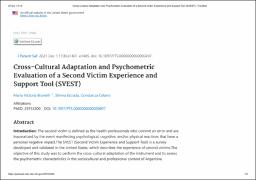| dc.contributor.author | Brunelli, Maria Victoria. | |
| dc.contributor.author | Estrada, Silvina. | |
| dc.contributor.author | Celano, Constanza. | |
| dc.date.accessioned | 2023-07-03T16:12:11Z | |
| dc.date.available | 2023-07-03T16:12:11Z | |
| dc.date.issued | 2021-12 | |
| dc.identifier.citation | J Patient Saf . 2021 Dec 1;17(8):e1401-e1405. | es |
| dc.identifier.issn | 1549-8425 | |
| dc.identifier.uri | https://riu.austral.edu.ar/handle/123456789/2208 | |
| dc.identifier.uri | https://journals.lww.com/journalpatientsafety/Abstract/2021/12000/Cross_Cultural_Adaptation_and_Psychometric.101.aspx | |
| dc.description | Disponible en: https://journals.lww.com/journalpatientsafety/Abstract/2021/12000/Cross_Cultural_Adaptation_and_Psychometric.101.aspx | es |
| dc.description.abstract | Abstract
Introduction
The second victim is defined as the health professionals who commit an error and are traumatized by the event manifesting psychological, cognitive, and/or physical reactions that have a personal negative impact.
The SVEST (Second Victim Experience and Support Tool) is a survey developed and validated in the United States, which describes the experience of second victims.
The objective of this study was to perform the cross-cultural adaptation of the instrument and to assess the psychometric characteristics in the sociocultural and professional context of Argentina.
Materials and Methods
The back translation of the instrument was carried out, which was approved by the authors. The survey consists of 29 questions divided into 9 dimensions corresponding to psychological stress, physical stress, colleague support, supervisor’s support, institutional support, non–work-related support, professional effectiveness assessment, change intention, and absenteeism. Subsequently, the survey was conducted to nursing professionals who had committed an error in medication. The reliability testing was done for internal consistency and the validity through construct validity using SPSS program.
Results
The population consisted of 452 nurses having an average of 10 years of practice (SD, 8.2). Eighty-two percent of those who made an error stated that they reported the event once it had occurred.
In our exploratory analysis, the survey presented no comprehension difficulties. The internal consistency of the instrument was adequate in its overall evaluation (Cronbach, 0.805).
Conclusion
The adaptation of SVEST is reliable for the use of this instrument in our environment to quantify the phenomenon and to be able to design strategies to reduce the impact of the error in the second victim. | es |
| dc.language.iso | en | es |
| dc.publisher | Lippincott, Williams & Wilkins | es |
| dc.rights | Attribution-NonCommercial-NoDerivatives 4.0 Internacional | * |
| dc.rights.uri | http://creativecommons.org/licenses/by-nc-nd/4.0/ | * |
| dc.subject | Second victim. | es |
| dc.subject | Patient safety. | es |
| dc.subject | Adverse events. | es |
| dc.title | Cross-Cultural Adaptation and Psychometric Evaluation of a Second Victim Experience and Support Tool (SVEST) | es |
| dc.type | Article | es |


